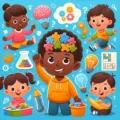Effective communication is a vital life skill that can be nurtured from a very young age. Playing communication games with children not only helps them express their thoughts and feelings better but also enhances their listening and understanding abilities. In this article, we’ll explore 14 fun and educational communication games that are perfect for kids of all ages.
Why Communication Games are Important for Kids
Communication games are more than just a way to pass the time. They are a tool to teach kids how to interact with others, recognize non-verbal cues, and develop empathy. By turning learning into play, children are more likely to engage and retain communication skills.
1. Telephone Game
A classic game that highlights the importance of clear communication. One child whispers a message to the next, and the message is passed along the line. The last child says the message out loud, revealing how it has changed.
2. Charades
This game helps children interpret non-verbal cues as they guess the word or phrase being acted out without verbal communication.
3. Emotion Cards
Create cards with different emotions displayed. Children pick a card and act out the emotion for others to guess, fostering emotional intelligence.
4. Storytelling Round-Robin
Each participant adds a sentence to a story. This encourages active listening and creative contribution.
5. Pictionary
Similar to charades, but with drawing. It’s a fun way for kids to convey messages without words.
6. 20 Questions
One child thinks of an object, and others ask up to 20 questions to guess what it is, learning to ask insightful questions and give clear answers.
7. Barrier Game
Two children sit back-to-back with a barrier between them. One describes a picture, and the other must draw it without seeing it, relying solely on verbal instructions.
8. Silent Signals
Create a set of hand signals or gestures that have specific meanings. Kids use these signals to communicate without speaking, enhancing their non-verbal communication skills.
9. Feelings Circle
A game where children sit in a circle and share something that made them happy or sad, promoting the expression of feelings and empathetic listening.
10. Compliment Tag
When a child is ‘it’, they tag others and give them a compliment, teaching positive communication and self-esteem building.
11. Two Truths and a Lie
Children state two truths and one lie about themselves, and others guess the lie. This game encourages critical thinking and getting to know each other.
12. Description Duel
Two children face each other and describe an object or picture. The others decide who gave the best description, fostering clear and descriptive communication.
13. Listening Bingo
Children have bingo cards with various words or phrases. As a story is read aloud, they mark off what they hear, sharpening their listening skills.
14. Talk Show Host
One child plays the host of a talk show and interviews other children. This game teaches them how to ask questions and articulate answers effectively.
FAQ
- What age group are these communication games suitable for?
- These games can be adapted for various age groups, but they’re generally suitable for children aged 4 to 12 years.
- How do communication games benefit children?
- Communication games help improve verbal and non-verbal communication, active listening, empathy, and social skills.
- Can these games be played in a classroom setting?
- Yes, these games are great for classrooms as they encourage team-building and can be played with large or small groups.
- Do these games require any special materials?
- Most games can be played with items found around the house or classroom, while others may require minimal preparation, like printing emotion cards.
- Are there benefits to playing communication games at home?
- Playing communication games at home can strengthen family bonds and improve communication within the household.









